

Travellers and Explorers from a Golden Age
by The Editorial TeamPublished on: 1st August 2020
Since the Quran said every able-bodied person should make a pilgrimage, or hajj, to Mecca at least once in their lifetime, thousands travelled from the farthest reaches of the Islamic empire to Mecca, beginning in the seventh century. As they travelled, they made descriptions of the lands that they passed through. Some of the most famous include...
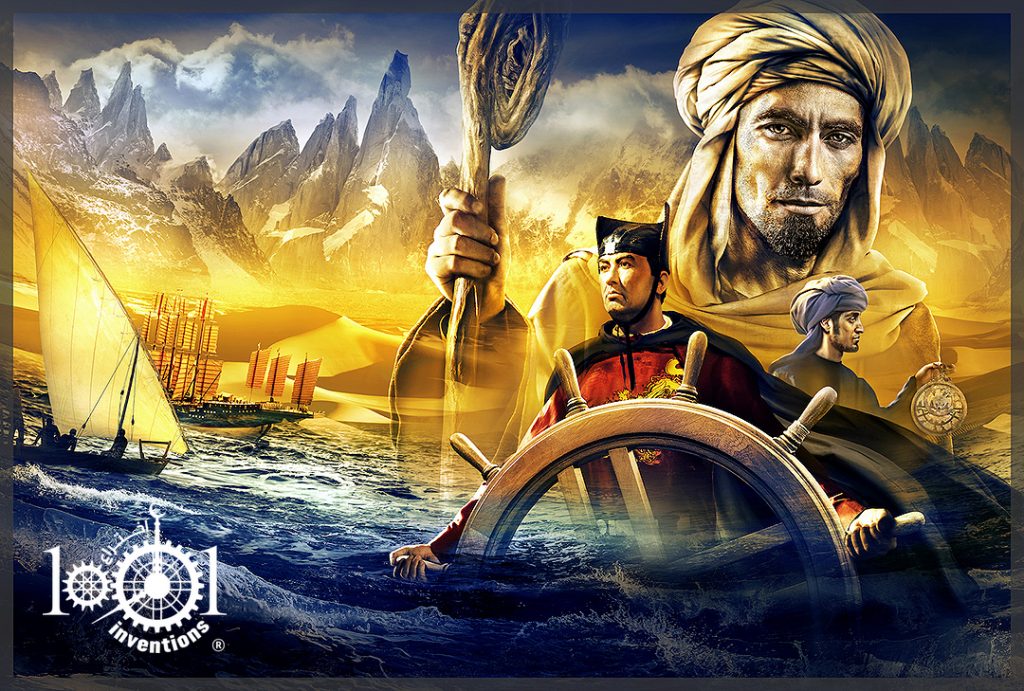
From left. Imaginary potrait of Zheng He, Ibn Battuta and Ibn Majid from 1001 Inventions’ ‘Journeys from a Golden Age’ (Source)
***
Editorial Note: Extracted from “1001 Inventions: The Enduring Legacy of Muslim Civilization Reference (4th Edition) Annotated”. First published in 1001 Inventions website – www.1001inventions.com/travellers
***
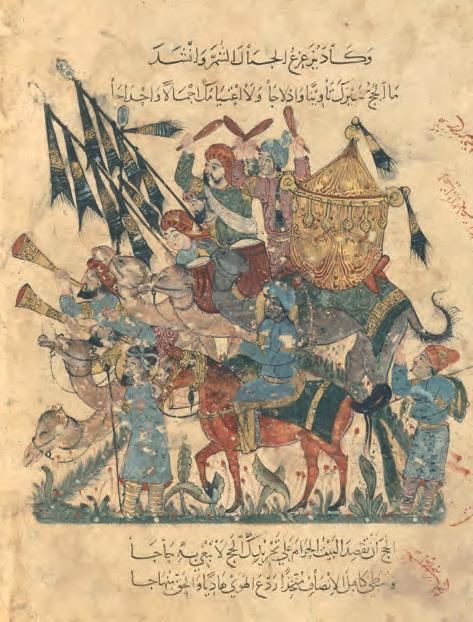
A 13th-century manuscript shows a caravan en route (Source: 1001 Inventions: The Enduring Legacy of Muslim Civilization, 3rd edition, page 247)
Al-Biruni, in the 11th century, wrote in his book the Demarcation of the Limits of the Areas that Islam has already penetrated from the Eastern countries of the earth to the Western.
It spread westward to Spain [Al-Andalus], eastward to the borderland of China and to the middle of India, southward to Abyssinia and the countries of Zanj Zanj [meaning black Africa from Mali to Kilwa (Tanzania) and Mauritania to Ghana], eastward to the Malay Archipelago and Java, and northward to the countries of the Turks and Slavs. Individual Muslim sultans ruled, and although there was conflict at times between them, an ordinary traveller could pass through the various regions.
Since the Quran said every able-bodied person should make a pilgrimage, or hajj, to Mecca at least once in their lifetime, thousands travelled from the farthest reaches of the Islamic empire to Mecca, beginning in the seventh century.
As they travelled, they made descriptions of the lands that they passed through. Some of the most famous include:
Al–Ya’qubi, 8th Century
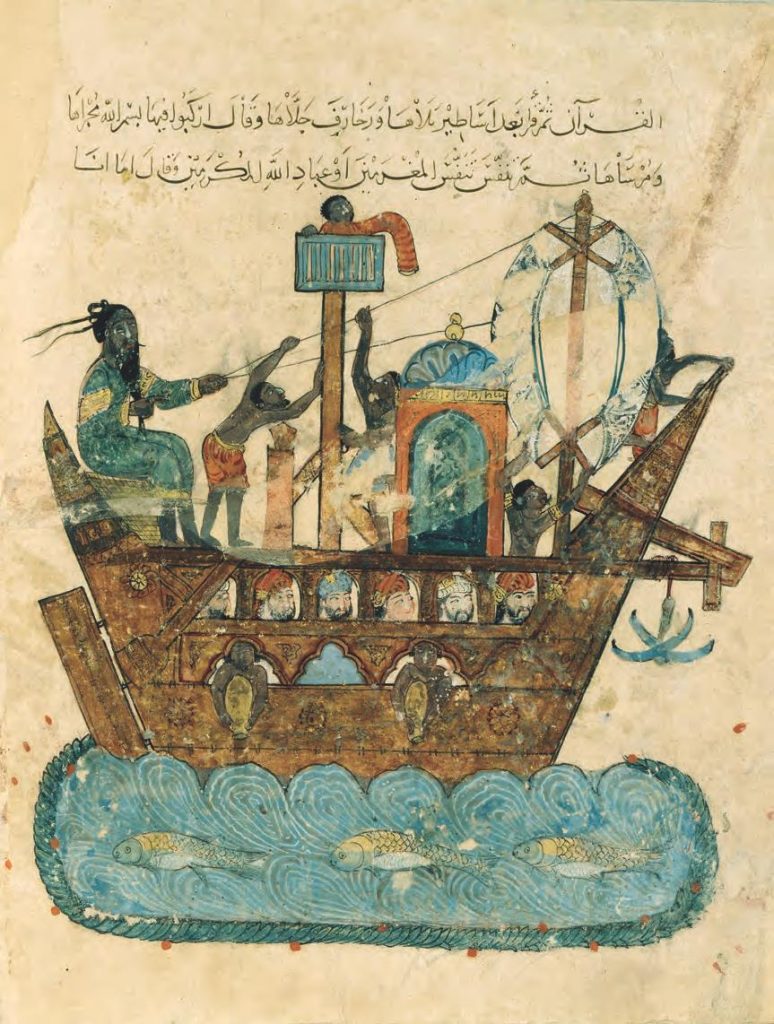
A 13th-century miniature depicts an eastern Muslim boat from the classical Arabic work of literature Maqamat al- Hariri. The Arabic writing refers to a sea voyage, and mentions a verse from the Quran referring to Noah’s ark. This is usually used as a blessing: “In the name of Allah, the one who protects the ship’s sailing, seafaring and berthing.” (Source: 1001 Inventions: The Enduring Legacy of Muslim Civilization, 3rd edition, page 248)
He wrote the Book of Countries, which he completed in 891 after a long time spent traveling, and he gave the names of towns and countries, their people, rulers, distances between cities and towns, taxes, topography, and water resources.[1]
Al-Ya’qubi wrote that “China is an immense country that can be reached by crossing seven seas; each of these with its own color, wind, fish, and breeze, which could not be found in another, the seventh of such, the Sea of Cankhay [which surrounds the Malay Archipelago] only sailable by a southern wind.”
Abu Zayd Hasan, 9th Century
He was a Muslim from Siraf, and told about boats that were sailing for China from Basra in Iraq and from Siraf on the Gulf. Chinese boats, much larger than Muslim boats, also visited Siraf, where they loaded merchandise bought from Basra. Abu Zayd also deals with the Khmer land and its vast population, a land in which indecency, he notes, is absent.
Ibn Wahhab, 9th Century
He was a trader from Basra who sailed to China and described the Chinese capital as divided into two halves, separated by a long, wide road. On one side the emperor, his entourage, and administration resided, and on the other lived the merchants and ordinary people. Early in the day, officials and servants from the emperor’s side entered the other, bought goods, left, and did not mingle again.[2]
Al–Muqaddasi, (ca 945–1000)
He was a geographer who set off from his home in Jerusalem many centuries before Ibn Battuta. He also visited nearly every part of the Muslim world and wrote a book called Best Divisions for Knowledge of the Regions, completed around 985.[3]

One of the accurate drawing based on personal observation is the sketch of the famous Lighthouse of Alexandria by the Andalusian traveller, Abu Hamid Al-Gharnati . He visited Alexandria first in 1110 and again in 1117. (Source)
Ibn Khurradadhbih, 10th Century
He wrote the Book of Roads and Provinces, which gave a description of the main trade routes of the Muslim world, referring to China, Korea, and Japan, and describing the southern Asian coast as far as the Brahmaputra River, the Andaman Islands, Malaya, and Java.[4] Ibn Khurradadhabih died in 912.
Ibn Fadlan, 10th Century
Ibn Fadlan was an Arab chronicler, and in 921 the caliph of Baghdad sent him with a diplomatic mission to the king of the Bulgars of the Middle Volga. He wrote an account of his journey, and this was called Risalah. Like Ibn Battuta’s Rihla, the Risalah is of great value because it describes the places and people of northern Europe, in particular a people called the Rus from Sweden.[5]

Remembering Omar Sharif (On the Left) as he appeared in the 1999 film “The 13th Warrior” which tells the story of 10th-century Arab traveller Ahmed Ibn Fadlan, played by Antonio Banderas (On the Right) and here you can watch Omar Sharif’s final film “1001 Inventions and the World of Ibn Al-Haytham”, which has been dedicated to his legacy. (Source)
Yaqut al-Hamawi, 13th Century
Imam Al-Shâfi, (767-820) |
He was a geographer who wrote the Dictionary of Countries about countries, regions, towns, and cities that he visited, all in alphabetical order, giving their exact location, and describing monuments, resources, history, population, and leading figures.[6]
Zakariya’ ibn Muhammad al-Qazwini, 13th Century
He left accounts of the marvellous creatures that thrive in the China Sea, notably very large fish (possibly whales), giant tortoises, and monstrous snakes, which land on the shores to swallow whole buffaloes and elephants.[7]
Ibn Sa’id al-Maghribi, 13th Century
He gave the latitude and longitude of each place he visited, and wrote much on the Indian Ocean islands and Indian coastal towns and cities.
Al-Dimashqi, A 14th Century
He gives very detailed accounts of the island of Al-Qumr, also called Malay Island or Malay Archipelago. He says there are many towns and cities; rich, dense forests with huge, tall trees; and white elephants. Also there lives the giant bird called the Rukh, a bird whose eggs are like cupolas. The Rukh is featured in a story about some sailors breaking and eating the contents of its egg; the giant bird chased after them on the sea, carrying huge rocks, which it hurled at them relentlessly. The sailors only escaped with their lives under the cover of night.[8]
This story, like other accounts by travellers, formed the basis of many of the tales that enrich Islamic literature, such as The Adventures of Sinbad the Sailor and The Thousand and One Nights. The richness of these thousand-year-old accounts has inspired many writers and filmmakers.

Pages from Ibn Fadhlan’s and al-Idrisi travel accounts about Rus/Vikings and a drawing of Oleg of Novgorod by Viktor Vasnetsov (Source)
Ibn Battuta, 14th Century
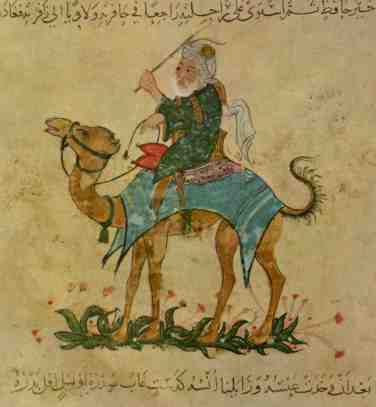
Imaginary Painting of Ibn Battuta
Ibn Battuta was only 21 on June 13, 1325, when he set out alone on his donkey at the beginning of a 3,000-mile overland journey to Mecca from Tangier in Morocco. He left his family, friends, and hometown, and would not see them again for 29 years. Some he never saw, because the plague reached them before he returned. He journeyed by walking, riding, and sailing more than 75,000 miles, through more than 40 modern countries..[9]
His accounts have placed the medieval world before us, so we know that gold traveled from south of the African Sahara into Egypt and Syria; pilgrims continuously flowed to and from Mecca; shells from the Maldives went to West Africa; pottery and paper money came west from China. Ibn Battuta also flowed along with the wool and the wax, gold and melons, ivory and silk, sheikhs and sultans, wise men and fellow pilgrims.[10] He worked as a qadi, a judge, for sultans and emperors, his journey a grand tour, mixing prayer, business, adventure, and the pursuit of knowledge. He returned to his native city three decades later and recounted stories of distant, exotic lands.[11] The sultan of Fez (Fes), Abu ’Inan, asked him to write down his experiences in a Rihla, a travel book, and with a royal scribe, Ibn Juzayy, he completed the task in two years. His account of medieval Mali in West Africa is the only record we have of it today.[12]
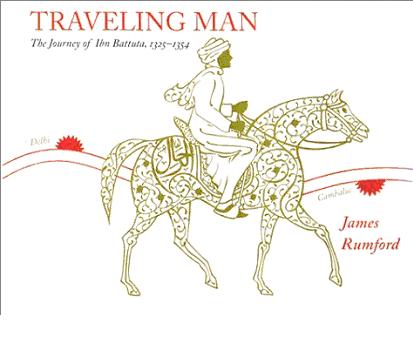
The Traveling Man: the Journey of Ibn Battuta, 1325-1354 by James Rumford (Houghton Mifflin, 2001). (Source)
Other travellers from the ninth and tenth centuries include Ibn al-Faqih, who compares the customs, food diets, codes of dress, rituals, and also some of the flora and fauna of China and India.[13] Ibn Rustah focuses on a Khmer king, surrounded by 80 judges, and his ferocious treatment of his subjects while indulging himself in drinking alcohol and wine, but also his kind and generous treatment of the Muslim.[14] Abu al-Faraj dwells on India and its people, customs, and religious observations. He also talks of China, saying it has 300 cities, and that whoever travels in China has to register his name, the date of his journey, his genealogy, his description, age, what he carries with him, and his attendants. Such a register is kept until the journey is safely completed. The reasoning behind this was a fear that something might harm the traveller and thereby bring shame to the ruler.
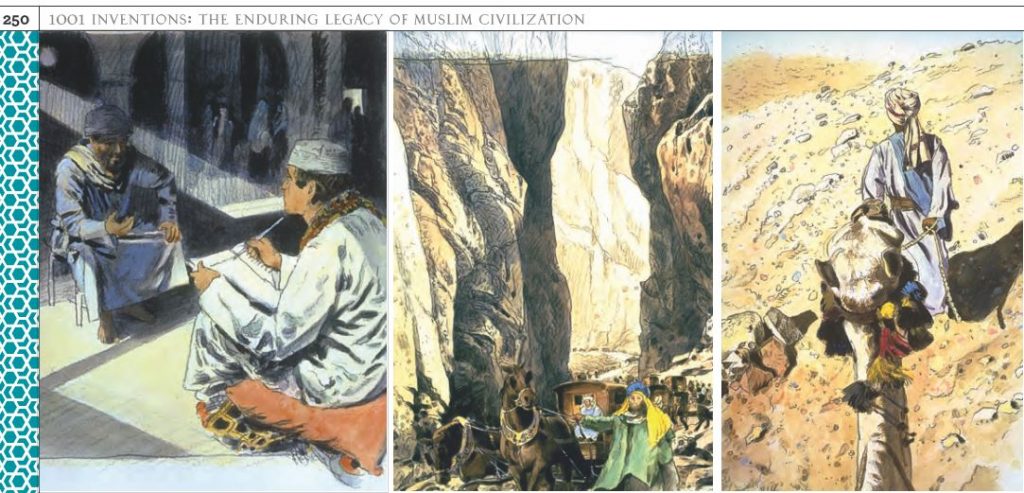
An artist’s rendering shows Ibn Battuta dictating his Rihla, passing through a dangerous gorge, and walking with his camel. (Source: 1001 Inventions: The Enduring Legacy of Muslim Civilization, 3rd edition, page 250)
***
Get the full story from 1001 Inventions: The Enduring Legacy of Muslim Civilization Reference (4th Edition) Annotated.
www.amazon.co.uk/1001-Inventions-Civilization-Reference-Annotated-ebook/dp/B0775TFKVY/
***
References
[1] The Kitab al-buldan appears in Bibliotheca ceocraphorum arabicorum Vll, M. J. de Goeje, ed. (1892); ed and trans into French by G. Wiet, Les Pays (1937).
[2] Carra de Vaux, Les Penseurs, op. cit., 57-58.
[3] Al Muqadassi, op. cit.
[4] S. M. Z. Alavi, Arabic Geography, op. cit., 27.
[5] On Muslim accounts of Scandinavia, see Harris Birkeland, Nordens hidstorie I middelalderen etter arabiskenkilder, Norske Videnskaps-Akademi i Oslo, Skrifter, Hist.-Filos. Klasse, 2 Scriffer, 1954, 2 (1954).
[6] Ibn Abd Allah al-Hamawi Yaqut, Jacut’s Geographisches Worterbuch, F. Wustenfeld, ed., 6 Vols. (Leipzig, 1866-70).
-C. Bouamrane and L. Gardet, Panorama de la Pensee Islamique (Paris: Sindbad, 1984), 260.
[7] Ibid, 302-04.
[8] The work was edited by A. F. Mehren, Quarto (St. Petersburg, 1866), 375 pages.
– G. Sarton, Introduction, op. cit., Vol. 3, 800.
– G. Ferrand, Relations de Voyages, 363-93.
[9] Ibn Battuta, Voyages d’Ibn Battuta, Arabic text accompanied by French trans. by C. Defremery and B. R. Sanguinetti, preface and notes by Vincent Monteil, I-IV (Paris, 1968, reprint of the 1854 ed.).
[10] Ibn Battuta, Travels in Asia and Africa, trans. and selected by H. A. R. Gibb (London: Routledge, 1929).
[11] F. Rosenthal, Ibn Battuta, Dictionary of Scientific Biography, op. cit., Vol. 1, 517.
– R. B. Winder, Ibn Battuta, in The Genius of Arab Civilisation, J. R. Hayes, ed., op. cit., 210.
[12] Ibn Battuta, Travels in Asia and Africa, Gibb, op cit.
[13] Ibn al-Faqih al-Hamadhani, auctore, Kitab al-buldan, M. J. De Goeje, ed., Bibliotheca geographorum arabicorum, 5 (Leiden, 1885).
[14] G. Sarton, Introduction, op. cit., Vol. 1, 635.
– G. Ferrand, Relations de Voyages, op. cit., 54-66.
[2] Carra de Vaux, Les Penseurs, op. cit., 57-58.
[3] Al Muqadassi, op. cit.
[4] S. M. Z. Alavi, Arabic Geography, op. cit., 27.
[5] On Muslim accounts of Scandinavia, see Harris Birkeland, Nordens hidstorie I middelalderen etter arabiskenkilder, Norske Videnskaps-Akademi i Oslo, Skrifter, Hist.-Filos. Klasse, 2 Scriffer, 1954, 2 (1954).
[6] Ibn Abd Allah al-Hamawi Yaqut, Jacut’s Geographisches Worterbuch, F. Wustenfeld, ed., 6 Vols. (Leipzig, 1866-70).
-C. Bouamrane and L. Gardet, Panorama de la Pensee Islamique (Paris: Sindbad, 1984), 260.
[7] Ibid, 302-04.
[8] The work was edited by A. F. Mehren, Quarto (St. Petersburg, 1866), 375 pages.
– G. Sarton, Introduction, op. cit., Vol. 3, 800.
– G. Ferrand, Relations de Voyages, 363-93.
[9] Ibn Battuta, Voyages d’Ibn Battuta, Arabic text accompanied by French trans. by C. Defremery and B. R. Sanguinetti, preface and notes by Vincent Monteil, I-IV (Paris, 1968, reprint of the 1854 ed.).
[10] Ibn Battuta, Travels in Asia and Africa, trans. and selected by H. A. R. Gibb (London: Routledge, 1929).
[11] F. Rosenthal, Ibn Battuta, Dictionary of Scientific Biography, op. cit., Vol. 1, 517.
– R. B. Winder, Ibn Battuta, in The Genius of Arab Civilisation, J. R. Hayes, ed., op. cit., 210.
[12] Ibn Battuta, Travels in Asia and Africa, Gibb, op cit.
[13] Ibn al-Faqih al-Hamadhani, auctore, Kitab al-buldan, M. J. De Goeje, ed., Bibliotheca geographorum arabicorum, 5 (Leiden, 1885).
[14] G. Sarton, Introduction, op. cit., Vol. 1, 635.
– G. Ferrand, Relations de Voyages, op. cit., 54-66.
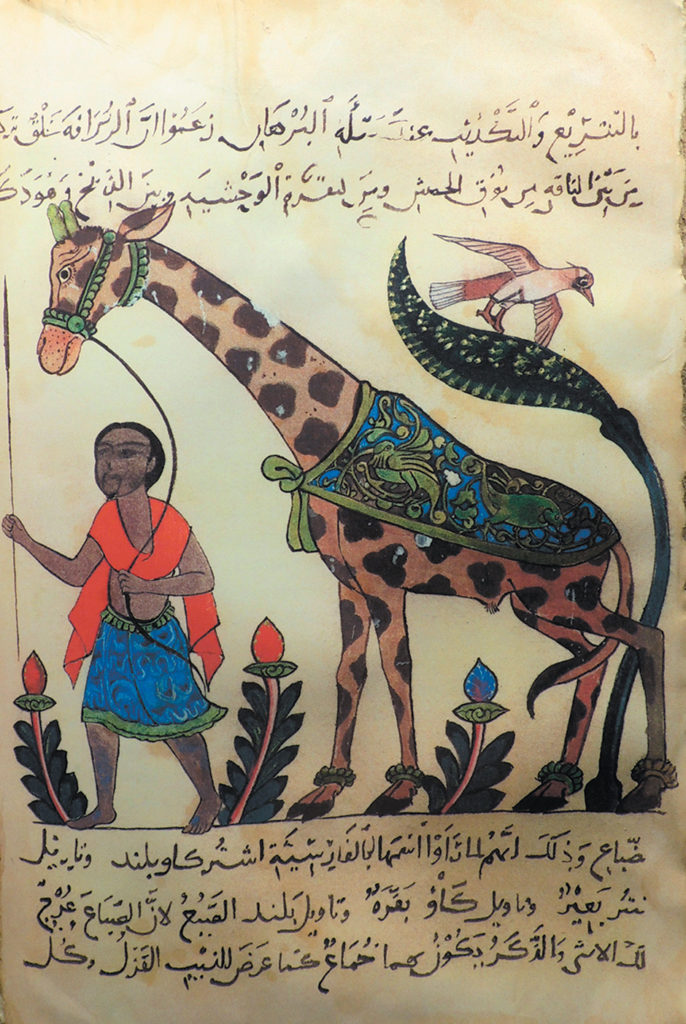
Al-Ǧāḥiẓ/Jahiz, Kitāb al-ḥayawān (Book of the animals), Syria, 15th C. Milan, Biblioteca Ambrosiana, Ms. arab. B 54, f. 36 (Source)






















No hay comentarios:
Publicar un comentario